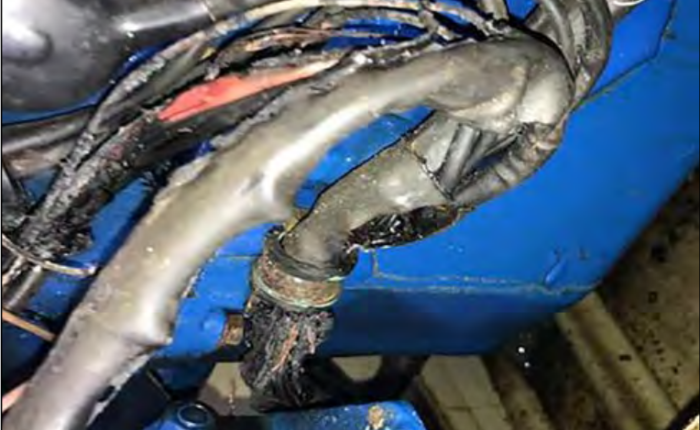In its latest Safety Digest report, UK MAIB published an incident concerning a 70-minute scheduled trip, when after 10 minutes, a small coastal passenger cruiser suffered a main engine failure that resulted in an engine room fire. There were no injuries but the vessel had to be taken out of service.
The Incident
In the beginning of the voyage, the master was first alerted to a problem with the port main engine when alarms sounded in the wheelhouse. The master’s initial reaction was to bring the engine speed control lever to neutral and stop the engine.
Then, without attempting to investigate or diagnose the problem, he silenced the alarms and attempted to restart the port engine. The engine failed to start so the master turned the vessel around, returned to the berth, and disembarked the passengers.
When the master opened the engine room door to investigate the problem, he saw smoke. Therefore, as he wasn’t able to enter the engine room, he decided to ventilate the space by opening a hatch on the vessel’s aft deck.
With the hatch open, the master saw flames on the top of the port engine. He ordered his crew to close all hatches and vents to the engine room, and then alerted the company office and requested the assistance of the local fire and rescue service. The engine room’s fixed CO2 fire-extinguishing system was then operated. The fire and rescue service attended the vessel and extinguished the fire within 30 minutes.
Post-fire examination of the port main engine and its electrical starting system identified an intermittent fault on the wheelhouse engine starter button (Figure 1). This allowed the engine starter motor solenoid to remain energised, and to overload and ignite the electrical cabling.
Lessons Learned
- On board the passenger vessel it was standard practice to start and stop the engines remotely from the wheelhouse without conducting routine inspections of the engines or the engine room. There are many things that can go wrong when engines are started or stopped, so they should always be closely inspected whenever their operating condition has changed.
- To avoid complacency, always err on the side of caution. Machinery alarms are provided for a reason, so positive action should be taken immediately to investigate their cause.
- The master and his crew demonstrated a lack of understanding about the potential consequences of opening a smoke-filled compartment to atmosphere. With little or no ventilation, a fire in an engine room can consume the remaining oxygen and decline in intensity. However, opening and ventilating the space before temperatures have returned to normal introduces oxygen to a hot area, and this can quickly feed or re-start a fire. In some cases a flashback and explosion may even occur. Close down the space, introduce a firereducing agent (i.e. CO2) and monitor boundary temperatures until recurrent measurements show consistently low readings.
































































